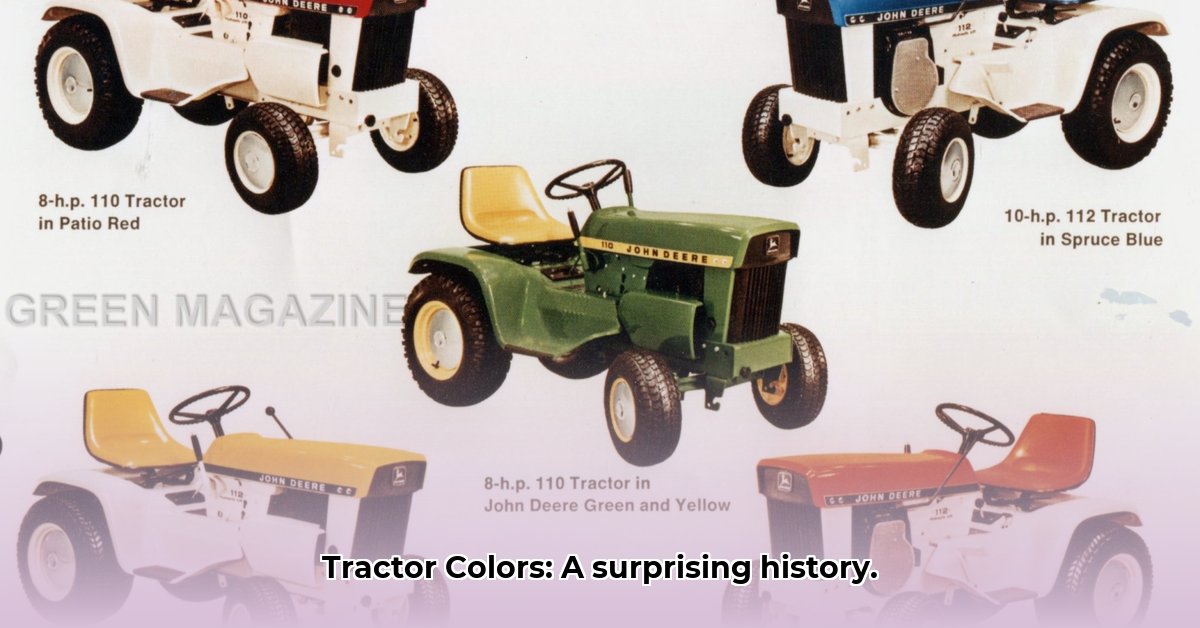
Imagine a world where every tractor looks the same – a drab, uniform landscape of beige and brown. Hard to picture, isn't it? The vibrant greens and reds that dominate our fields today are not just aesthetic choices; they represent a fascinating history of branding, marketing, and the ever-growing importance of sustainability in agriculture. This journey through the chromatic evolution of the tractor reveals a surprising story of innovation, competition, and our evolving relationship with the environment. For a specific example of historical tractor paint colors, see this page on Farmall 656 paint.
From Mud-Colored Machines to Marketing Masterpieces
The earliest tractors were far from stylish. Their colors were dictated by practicality and availability, resulting in a palette of muted grays, browns, and blacks. These were machines built solely for function, not fashion. The paint often consisted of whatever surplus materials were on hand; some agricultural historians speculate that regional variations in shade might reflect unique local sources of paint rather than intentional branding choices. This simplicity underlines the era's focus: work, not aesthetics.
The Green and Red Revolution: A Branding Triumph
The landscape shifted dramatically with the emergence of John Deere's iconic green and International Harvester's bold red. These weren't accidental choices; they were strategic marketing masterstrokes. Suddenly, color became synonymous with brand identity, transforming tractors from mere agricultural machinery into powerful symbols of quality and success. This shift, notes Dr. Anya Sharma, Professor of Agricultural Marketing at Cornell University, "marked a critical turning point, leveraging color psychology to build brand recognition and farmer loyalty." The tractor, once a simple tool, became a status symbol within farming communities.
Beyond the Classics: A Spectrum of Shades
While John Deere green and International Harvester red endure, today's tractor market showcases a dazzling array of colors. Manufacturers now use color as a tool for innovation and differentiation, introducing limited-edition shades to spark excitement and exclusivity. This mirrors strategies employed in other industries, such as automobiles, where unique colors create excitement and boost sales. This approach, explains Michael Davies, Head of Marketing at Case IH, "allows us to connect with different customer segments and generate buzz around new models." The strategic use of color taps into our inherent desire for distinction and individuality.
The Growing Influence of Sustainability: A Greener Future?
The future of tractor colors is inextricably linked with environmental responsibility. What began as a marketing tactic is now evolving into a reflection of our collective values. Concerns about volatile organic compounds (VOCs) – harmful chemicals released by many traditional paints – are driving manufacturers to adopt more sustainable alternatives. Paints with reduced or eliminated VOCs are becoming the industry standard, and the use of bio-derived ingredients is on the rise. This shift isn't merely cosmetic; it directly addresses the health and environmental concerns of farmers and the wider community. Dr. Emily Carter, a leading researcher in sustainable materials at MIT, states, "The drive towards eco-friendly paints reflects a growing awareness of the environmental impact of manufacturing and a commitment to a greener future."
A Colorful Timeline: The Evolution of Tractor Hues
| Era | Dominant Colors | Key Influences |
|---|---|---|
| Early 1900s | Black, Gray, Brown | Practicality, Material Availability |
| Mid-1900s | Green, Red | Brand Building, Marketing Strategies |
| Present Day | Diverse, Including Green and Red | Brand Identity, Sustainability, Market Trends |
How to Choose Eco-Friendly Tractor Paint Colors
The choice of tractor paint is no longer purely aesthetic. It's a reflection of environmental responsibility. Considering the impact of VOCs, choosing eco-friendly paints is crucial. But how do farmers make informed decisions about color and sustainability?
Choosing Eco-Friendly Tractor Paints: A Practical Guide
Prioritize Water-Based Paints: Water-based paints significantly reduce VOC emissions compared to solvent-based options. Though they may require more coats, their environmental benefits are substantial.
Optimize Application: Employing High-Volume, Low-Pressure (HVLP) spray systems minimizes waste and reduces VOC release.
Consider Color and Climate: Lighter colors reflect more sunlight, reducing heat absorption and potentially improving fuel efficiency, particularly in warmer climates.
Verify Durability: Before committing, always check the manufacturer's data on the paint's longevity and resistance to chipping, fading, and weathering. A long-lasting paint reduces the need for frequent reapplications.
The journey of tractor colors reflects a fascinating interplay between innovation, branding, and sustainability. From drab beginnings to today's vibrant hues, the story continues to unfold, driven by technological advancements and a growing commitment to a greener future for agriculture.